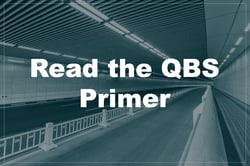
Free Report: An Analysis of QBS in the Procurement of Engineering Services
Research Shows QBS Remains the Primary Procurement Tool for Competitive Bidding, Particularly Among State Governments
The new updated Analysis of QBS in the Procurement of Engineering Services finds that QBS provides direct benefits in both the design and construction phases of a wide variety of public and private sector projects. From direct cost and schedule benefits to indirect benefits of reduced management issues and increased innovation, QBS demonstrates a clear benefit when applied across a host of project types, sizes, and geographic regions.
Key Findings:
• QBS outperforms the national performance in cost growth (3 percent versus 6 percent)
• QBS outperforms the national performance schedule growth (7 percent versus 10 percent)
• QBS projects achieve a greater degree of consistency in terms of project success than non-QBS projects
• There is a strong association between the use of QBS and the quality of construction documents developed by the design team
• Projects incorporating QBS have a greater likelihood of producing innovative solutions
Want to learn more? Keep scrolling for more insights.
Please fill out the form to get the report:
Listen to the Podcast on QBS
What is QBS?
Qualifications-Based Selection (QBS) is a procurement process through which firms compete for work based on experience and technical expertise, rather than competing for the lowest cost bid. Under QBS, after firms are evaluated and shortlisted based on their qualifications, the top-ranked firm is selected for price negotiations, and, ideally, a fair and reasonable price is reached based on a detailed scope of the project. If an agreement on price cannot be reached with the most qualified firm, negotiations commence with the second most qualified firm. In most cases, the top-ranked firm is selected at a price that fits the client's budget.


QBS Saves Money

QBS Saves Time
QBS procurement results in fewer project delays and improves the likelihood of owner satisfaction with the overall project.

QBS Simplifies Complex Projects
QBS ensures complex projects have the best talent by engaging experienced, stable design teams.

QBS Delivers Innovation
When firms have greater opportunity to explore innovations, they can produce better outcomes for clients. QBS enables innovation because price is not the only driving factor.

QBS Drives Procurement
QBS is the primary procurement tool – even for agencies that experience lean staffing and high turnover.

Key data:
- Cost growth on projects where QBS was used to procure engineering services was half the national average (3 percent versus 6 percent)
- Devoting more design effort has been shown to reduce the project’s final cost from early estimates by solving construction problems during the design phase when the costs are lower than after construction has commenced.
- A study of 122 publicly procured A/E projects analyzed across North America revealed that greater consultation qualifications had no correlation with higher design fee costs.
Case Study: The Ripken Experience
- A unique project because it required close cooperation between the design team and the city to meet specific objectives.
- Technical challenges required a team that had [specific] experience in athletic field design as well as stormwater management on a large site with unique drainage requirements.
- The QBS process provided for a team with an understanding that the qualifications and experience needed for this type of project were in place prior to the start of the project.


Key data:
- Hiring the most experienced and qualified design team reduces project schedule growth as compared to the national average (7 percent versus 10 percent).
- Specifically, 48%, or about half of the QBS projects met all construction milestones with no adjustment in schedule required. Conversely, only 32% of non-QBS projects had the same performance. This is a 50% increase in the number of projects that met all schedules. From this result, it can be seen that the experience brought forward in QBS has an impact on the construction process.
- The teams with the greater experience working together, and in that sector, consistently produced documents that resulted in fewer delays during the construction process.
Case Study: St. Maries River RR Bridge & St. Joe River Bridge
- The project presents an enlightening look into the positives and negatives of alternative delivery systems, specifically Best-Value procurement.
- The complex project presented numerous challenges that required expertise, innovation, and collaboration.
- While the design-construction collaboration was successful, the lack of experience in using alternative delivery methods contributed to missed deadlines.


Key data:
- There is a strong link between the level of complexity, the project outcomes, and the use of QBS as the procurement method. As the complexity of the project grows, the positive impact of using QBS grows along with it.
- Projects with community involvement, social components, and additional community features require design firms with broader knowledge and understanding. This brings QBS into a positive position. Less qualified and experienced firms might have a harder time balancing these complicated social factors, [thus elevating] the benefits of using QBS procurement to select more qualified, experienced, and ultimately successful design firms.
- QBS can encourage engineering firms to team in ways that provide the owner with the greatest set of qualifications to successfully complete the project.
Case Study: Lakefront Gateway I-794 Ramps
- This project required a significant amount of public outreach and involvement between the city, state, county, and numerous other stakeholders, making the need for a capable firm more important than a less expensive one.
- Less qualified and experienced firms might have a harder time balancing complicated social factors.
- The project designers found that QBS was a necessary component to the success of the project due to its complexity given the need for a firm that could manage all the moving parts effectively.


Key data:
- When QBS was the procurement method used, projects that mentioned complexity either in terms of physical challenges or in terms of social or political challenges were consistently higher in terms of innovations.
- Direct cost and schedule benefits, indirect benefits of reduced management issues, and increased innovation are why QBS demonstrates a clear benefit when applied across a series of project types and geographic regions.
- Innovation is an indirect measure of project complexity as more complex projects often require more innovative solutions to address those specific project challenges. Second, innovation is a measure of how design firms approach a project in terms of the flexibility of solutions they may bring to the project.
Case Study: The Ripken Experience
- This design focused on innovation.
- The key to the project success was a team that worked closely together to develop solutions to the technical challenges.
- The combination of experience and a focus on innovation moved this project from satisfying the participants expectations to exceeding their expectations.


Key data:
- Counties, municipalities, school districts, and other agencies are found to be using QBS closer to the 41-60% range. While this remains strong, it illustrates a gap that need to be bridged.
- Turnover in procurement departments has been increasing over the last decade with long-term civil servants retiring and procurement turning over to less experienced individuals in a number of areas. Concurrent with this turnover has been a significant increase in the level of advocacy from alternative procurement groups. In this combination, the level of knowledge concerning the core benefits of utilizing QBS has dropped amongst some local jurisdictions.
- There are many smaller jurisdictions where procurement responsibilities do not fall to a dedicated staff. Rather, procurement is part of a larger set of responsibilities that a single individual may have. In these cases, individuals have reported that they believe QBS may take longer up front and this presents a capacity issue.
Case Study: Five Location FEMA Project
- Using QBS in a design-bid-build process, along with a review of fees, provided a well-rounded combination of quality, service, and value to taxpayers.
- QBS ensured an experienced team was put on the project instead of a cheaper, but possibly much less competent team.
- Based on feedback by the lead design firm, the project showcases how QBS produces the right outcomes for success.

Additional QBS Resources
Federal and state statutes and regulations:
- Title 40 U.S.C. 1101-1104
- Federal Acquisition Regulation (FAR) Part 36
- Federal Programs
- State QBS Matrix
ACEC Policy Statement:
Previous Studies and Other Guidance Materials:
- Maryland & Florida QBS Study – Executive Summary and Conclusions
- An Analysis of Issues Pertaining to Qualifications-Based Selection, Paul S. Chinowsky, PhD & Gordon A. Kinsley, PhD
- A Guide to Qualifications-Based Selection of Design Professionals
- APWA Red Book on Qualifications-Based Selection (APWA)
- QBS Brochure: Why Value Outweighs Cost in the Selection of Engineering Services

The ACEC Research Institute’s mission is to deliver knowledge and business strategies that guide and elevate the engineering industry and to be the leading source of knowledge and thought leadership for creating a more sustainable, safe, secure and technically advanced built environment.
1400 L Street NW, Suite 400, Washington DC 20005-3592 - P: 202.347.7474 - E-mail: institute@acec.org



